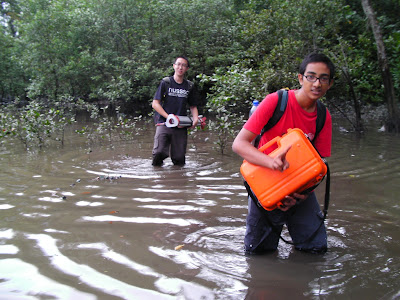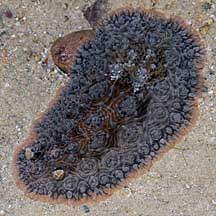So, anyway...
Day 4
Fully recharged from my previous work, I came back to the mangroves! Well, almost...
 |
| We got rained in... |
Once back at the lab, Rick taught me how to use the total station. The total station, using trigonometry and a little bit of magic (It's really complicated math) is able to determine the elevation of a point very far away. Despite how complicated it sounds, the operating system of the total station is actually pretty easy and straightforward to use. The main trick is getting the tripod to be totally level. That takes about 5-10 minutes of trial and error.
 |
| That's me adjusting the tripod to make it totally level. It's more fun that it looks! |
Rick believes that accurate equipment is necessary for good ecology. After visiting his lab, I agree. There's no point in wasting time and energy in collecting inaccurate data with inferior equipment. That's why accurate and precise equipment is really needed to do proper data analysis.
Day 5
Once more, I visited Rick in his lab and met up with his friend Aloysius, who was looking to get some experience in muddy environments. Naturally, the mangroves were the perfect practice area. So, we set off!
 |
| Yes, we do this for fun. Why do you ask? |
 |
| It put a demonic spark of joy in my eye. |
So, we mapped out many trees that Dipti and Rick had tagged on the day I took a hiatus. Along the way, we met some friendly residents of the mangrove, including a tree climbing crab.
 |
| Which was... climbing a tree. |
Aloysius took the chance to practice his swordsmanship as well.
 |
| En garde! |
Day 6
 |
| This was how high the tides were. |
 |
| Here's us fooling around before the tour. |
So, during the tour, Rick introduced us to many species of mangroves that we were unable to see on the other side, such as Sonneratia trees. Again, I should do a dummy's guide to mangroves sometime. We also saw Nipah! It's the only palm that grows in saltwater. The fruit is naturally sweet, and is a vital addition to Ice Kachang.
 |
| That's the fruit. Inside, is the attap chee |
We also saw proof that people have lived in the Mandai Mangroves. It's possible that these structures were built by the fishing village that lived here and was relocated by urbanization. It was cool, albeit slightly eerie to think that many people had been born and had died in that area. In a sense, is it not our national heritage?
Pretty cool huh? I was amazed too!
 |
Rick showed us the setup for another experiment. This was attached. Guess who did the Tamil translation...
THAT'S RIGHT! I DID! OH YEAH!
THAT'S RIGHT! I DID! OH YEAH!
Anyway...
We also got a great view of Malaysia!
Rick taught us all the distinguishing features of the mangrove trees. Truly an enriching experience.
Once the tide receded, we returned to the sandbar and continued mapping and tagging the trees. It was, as usual really hard work. Once it ended, we all breathed a sigh of "TGIF!"
\
Remember, Rick always needs help. So, do try to volunteer for his cause. Where else can you go all He-man in the mangroves?
 |
| It looks like 'Hey Rick', but it actually reads 'Help Rick' |
SO GO HELP HIM! Do the manly thing of walking in knee-deep mud... for science!
http://mangroveactionsquad.wordpress.com/be-a-mangrover-help-us-out/
http://mangroveactionsquad.wordpress.com/be-a-mangrover-help-us-out/








































